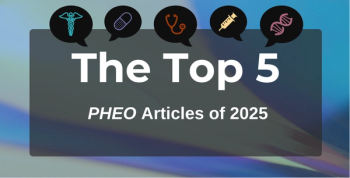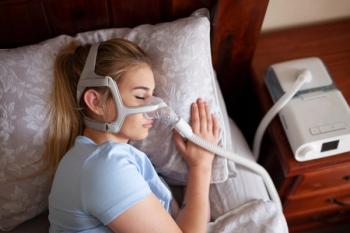
Late-Breaking Data From Clinical Trials Show Promise for the Future of COPD Treatment
Study authors shared late-breaking data in a session on clinical trial results in pulmonary medicine at the American Thoracic Society 2024 International Conference.
Investigators shared late-breaking data from 3 studies in a session titled “Breaking News: Clinical Trial Results in Pulmonary Medicine” at the
ARISE Study Highlights Efficacy and Safety of ALIS in Treating Mycobacterium Avium Complex Lung Disease
According to presenter Charles L. Daley, MD, from National Jewish Health and the University of Colorado School of Medicine, the ARISE study has provided promising new data on the treatment of Mycobacterium avium complex lung disease (MACLD), a major cause of nontuberculous mycobacterial lung infections. The condition, often exacerbating chronic respiratory diseases such as chronic obstructive pulmonary disease (COPD) and bronchiectasis, is associated with significant symptom burdens and remains challenging to treat effectively.1
Despite guideline-based treatments, many patients fail to achieve successful outcomes, highlighting the need for improved therapeutic strategies and robust patient-reported outcome (PRO) instruments. The ARISE study aimed to validate the Quality of Life-Bronchiectasis Respiratory Domain (QOL-B RD) and Patient-Reported Outcomes Measurement Information System-Fatigue (PROMIS-F) tools, assessing their reliability, validity, and responsiveness in capturing symptom improvements in patients with MACLD. Additionally, the study evaluated the microbiologic outcomes and safety of treatment regimens.
ARISE enrolled adults with noncavitary MACLD who had not yet received antibiotic therapy for their current infection. Participants were randomized 1:1 to receive either 590 mg of amikacin liposome inhalation suspension (ALIS) or a control (empty liposome) along with 250 mg of azithromycin and 15 mg/kg of ethambutol daily for 6 months, followed by 1 month off treatment.
The primary end points focused on the psychometric properties of the QOL-B RD and PROMIS-F instruments, including cross-sectional properties, test-retest reliability, and meaningful within-patient change using anchor-based methods and empirical cumulative distribution function (eCDF) plots. Secondary end points included culture conversion rates, time to culture conversion, time to first negative culture, and safety assessments.
The study enrolled 99 patients (48 in the ALIS arm and 51 in the comparator arm) with a median age of 69 years. The majority were female (77.8%) and White (80.8%). For 72.7% of patients, this was their first MAC lung infection. The infections were predominantly caused by M avium (32.3%) and M intracellulare (43.4%).
The QOL-B RD and PROMIS-F instruments demonstrated strong reliability and validity in this patient population. The eCDF plots showed clear separation in symptom scores between patients reporting improvements, defined as 1 or more category changes in Patient Global Impression of Severity, and those reporting no change, confirming the responsiveness of these PROs.
By month 6, the culture conversion rate was significantly higher in the ALIS arm (80.6%) compared with the comparator arm (63.9%). This trend continued at month 7, a month post treatment, with conversion rates of 78.8% for ALIS vs 47.1% for the comparator (P = .0010). Additionally, patients in the ALIS arm achieved their first negative culture-defining conversion faster, with 74.3% achieving this by month 1, compared with 46.7% in the comparator arm. The median time to first negative culture was 1.0 month for ALIS and 2.0 months for the comparator.
“Among those who have been converted by month 6, the first negative culture that defined that was observed in 1 month and 74% of those on ALIS vs only about 47% in the comparator arm in patients in the ALESTORM version about a month earlier, and there was no resistance that developed, no new safety signal,” Daley said in the presentation.
Common treatment-emergent adverse events in the ALIS arm included dysphonia and cough, but no serious adverse events were related to ALIS, and no deaths were reported.
“So the next thing we're waiting for is this 15-month confirmatory study that is ongoing now,” he explained. “This is evaluating the efficacy and safety of ALIS in the same patient population. The difference is this is 12 months of treatment, and then evaluating 3 months off treatment.“
Tezepelumab Shows Promise in Reducing COPD Exacerbations in Phase 2a COURSE Study
Late-breaking data on the potential benefits of tezepelumab in treating COPD were shared by Dave Singh, MD, of Manchester University NHS Foundation Trust, University of Manchester. The researchers investigated tezepelumab efficacy and safety in patients with moderate to very severe COPD, a population that continues to suffer from significant exacerbations despite standard therapy.2
TSLP is an epithelial cytokine involved in initiating and perpetuating chronic airway inflammation, making it a promising target for COPD treatment. The COURSE study aimed to evaluate whether tezepelumab could reduce COPD exacerbations in patients receiving triple inhaled maintenance therapy—comprising inhaled corticosteroids (ICS), long-acting β-agonists (LABA), and long-acting muscarinic antagonists (LAMA)—and who had a history of frequent exacerbations.
This double-blind study enrolled 333 patients aged 40 to 80 years, randomized 1:1 to receive either tezepelumab 420 mg or placebo subcutaneously every 4 weeks for up to 52 weeks. Key eligibility criteria included at least 2 moderate or severe COPD exacerbations in the previous year and ongoing triple inhaled maintenance therapy. Exclusion criteria included a history of asthma or other significant pulmonary diseases, with no exclusions based on baseline blood eosinophil count (BEC).
The primary end point was the annualized rate of moderate or severe COPD exacerbations over 52 weeks. Secondary end points included the rate of severe exacerbations, changes in prebronchodilator forced expiratory volume in one second (FEV1), St. George's Respiratory Questionnaire (SGRQ) total score, and COPD Assessment Test (CAT) score from baseline to week 52. Safety was also assessed.
Primary end point:
- Tezepelumab reduced the annualized rate of moderate or severe COPD exacerbations by 17% compared with placebo (90% CI, −6 to 36; P = .1042), which was not statistically significant.
- Notably, greater reductions were seen in patients with baseline BEC of at least 150 cells/µL (37%; 95% CI, 7%-57%) and at least 300 cells/µL (46%; 95% CI, 15%-75%).
Secondary end points:
- Tezepelumab showed a numerical reduction in the rate of severe exacerbations by 48% (95% CI, 11%-76%).
- Improvements in prebronchodilator FEV1 were observed (0.026 L vs −0.029 L with placebo; difference: 0.055 L; 95% CI, 0.014-0.096).
- SGRQ scores improved with tezepelumab (−4.80 vs −1.86 with placebo; difference: −2.93; 95% CI: −6.23 to 0.36).
- CAT scores also showed better outcomes with tezepelumab (−3.0 vs −1.2 with placebo; difference: −1.86; 95% CI, −3.31 to −0.40).
Adverse events and serious adverse events were balanced between the tezepelumab and placebo groups. No new safety signals were identified, supporting tezepelumab's favorable safety profile.
"In this phase 2 study, where we were looking for an effect on moderate to severe exacerbations, there was a numerical reduction of 17% which did not reach statistical significance," Singh said in his presentation. "We similarly saw numerical reductions in severe exacerbations, improvements in lung function and quality of life. As a preplanned secondary analysis, we saw that the benefit of tezepelumab increased with iron, blood eosinophil counts, and the safety and tolerability in this phase 2 study were consistent with what we know about the drug."
Dupilumab Significantly Reduces Exacerbations in COPD Patients with Type 2 Inflammation: Findings From the NOTUS Trial
Surya Bhatt, MD, an associate professor in the Division of Pulmonary, Allergy, and Critical Care Medicine, University of Alabama at Birmingham, shared late-breaking data from the phase 3 NOTUS trial, which provided compelling evidence that dupilumab, a fully human monoclonal antibody, significantly reduces exacerbation rates and improves lung function in patients with COPD with type 2 inflammation.3
Type 2 inflammation in COPD is driven by cytokines such as IL-4 and IL-13. Dupilumab, which blocks the shared receptor component of IL-4 and IL-13, has shown efficacy in reducing exacerbations in COPD with type 2 inflammation, as evidenced by the phase 3 BOREAS trial. The NOTUS trial aimed to replicate and further evaluate the efficacy and safety of dupilumab in this patient population.
The NOTUS trial was a 52-week, phase 3, randomized, double-blind, placebo-controlled study. Participants were assigned to receive either subcutaneous dupilumab 300 mg every 2 weeks or placebo, as an add-on to their existing therapy. Eligible patients had moderate to severe COPD with type 2 inflammation, indicated by BEC of at least 300 cells/μL at screening. They were also on triple inhaled maintenance therapy ICS, LABA, and LAMA, or LABA/LAMA if ICS was contraindicated. Key inclusion criteria included:
- Aged 40 to 85 years
- Current or former smoker (≥10 pack-years)
- Postbronchodilator FEV1/forced vital capacity (FVC) ratio less than 0.7 and postbronchodilator FEV1 % predicted between 30% and 70%
- History of chronic bronchitis or chronic cough
- At least 2 moderate or 1 severe exacerbation in the previous year
Exclusion criteria included a current diagnosis or history of asthma or other significant pulmonary diseases.
A total of 935 participants were randomized, with 465 receiving placebo and 470 receiving dupilumab. The primary end point analysis, conducted with an interim data cut (92% information fraction), revealed the following key results.
Primary end point:
- Dupilumab reduced the annualized rate of moderate to severe COPD exacerbations by 34% compared with placebo (relative risk, 0.664; 95% CI, 0.535-0.823; P = .0002).
Secondary end points:
- At week 12, dupilumab significantly increased prebronchodilator FEV1 by a least squares mean difference of 82 mL compared with placebo (P < .0001).
- This improvement in FEV1 was maintained at week 52, with a least squares mean difference of 62 mL (P = .0182).
- Dupilumab improved the SGRQ total score at week 52 by a least squares mean difference of −3.37 compared with placebo (nominal P = .0068).
Safety:
- The safety profile of dupilumab was consistent with previous studies, including the BOREAS trial. Treatment-emergent adverse events were balanced between the dupilumab and placebo groups, indicating good tolerability.
"Dupilumab significantly reduced exacerbations, just like they saw in the BOREAS trial, improved lung function and quality of life as well as symptoms in patients with COPD and type 2 inflammation," Bhatt said in his presentation. "And the safety was consistent with its known safety profile and it's already approved for 6 to 7 indications and is being used in clinical practice. And we saw exactly the same kind of safety profile infrastructures."
References
1. Daley CL, Chalmers JD, Flume PA, et al. Microbiologic outcomes from a randomized, double-blind trial of amikacin liposome inhalation suspension in adults with newly diagnosed or recurrent Mycobacterium avium complex lung disease: the ARISE study. Am J Respir Crit Care Med. 2024;209:A1033.
2. Singh D, Bafadhel M, Brightling CE, Rabe KF, Han MK, Bhutani M; COURSE study investigators. Tezepelumab in adults with moderate to very severe chronic obstructive pulmonary disease (COPD): efficacy and safety from the phase 2a COURSE study. Am J Respir Crit Care Med. 2024;209:A2782.
3. Bhatt SP, Rabe KF, Hanania NA, et al. Efficacy and safety of dupilumab in patients with moderate-to-severe COPD and type 2 inflammation: phase 3 NOTUS trial. Am J Respir Crit Care Med. 2024;209:A2996.
Newsletter
Stay ahead of policy, cost, and value—subscribe to AJMC for expert insights at the intersection of clinical care and health economics.







































